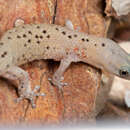en
names in breadcrumbs


The Neiba agave sphaero (Sphaerodactylus schuberti), also known commonly as the Neiba agave geckolet[2] and Schubert's least gecko,[3] is a species of lizard in the family Sphaerodactylidae. The species is endemic to the Dominican Republic.[2]
The specific name, schuberti, is in honor of German zoologist Andreas Schubert.[3]
The preferred habitat of S. schuberti is in dead agaves in xeric forest at an altitude of 273 m (896 ft).[1][4]
 Distribution of Sphaerodactylus schuberti (known range; red).
Distribution of Sphaerodactylus schuberti (known range; red). The Neiba agave sphaero (Sphaerodactylus schuberti), also known commonly as the Neiba agave geckolet and Schubert's least gecko, is a species of lizard in the family Sphaerodactylidae. The species is endemic to the Dominican Republic.